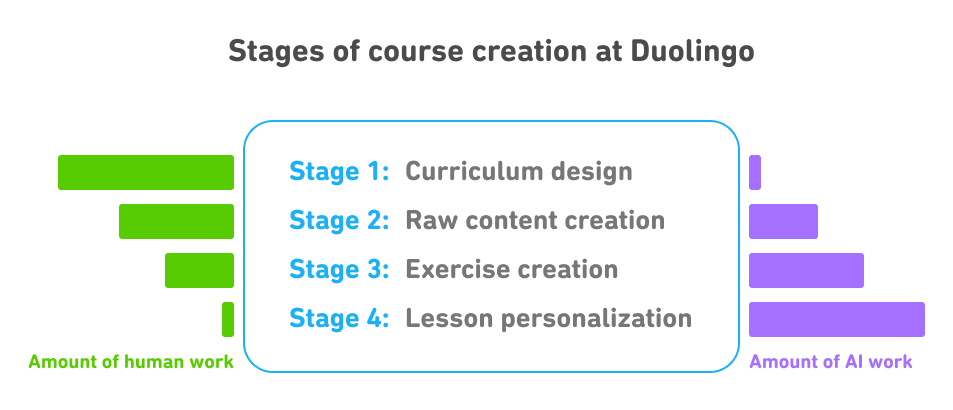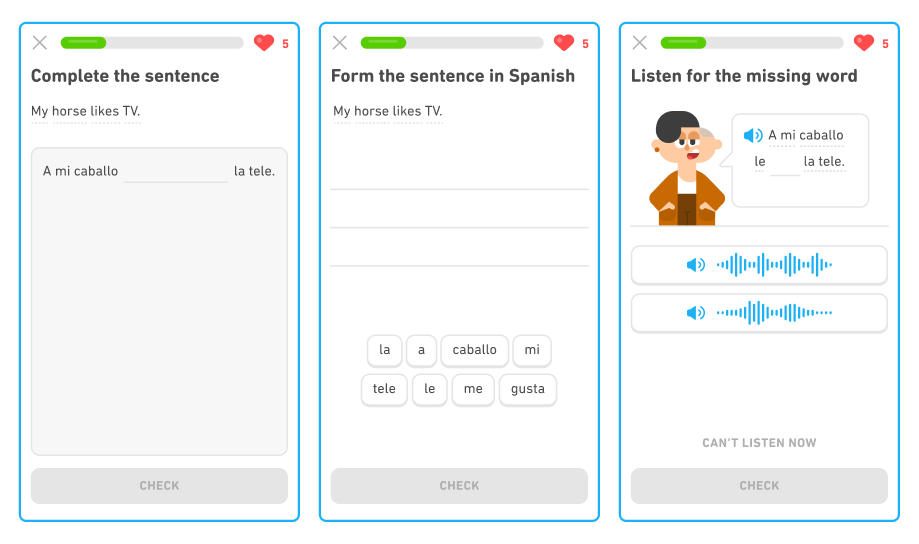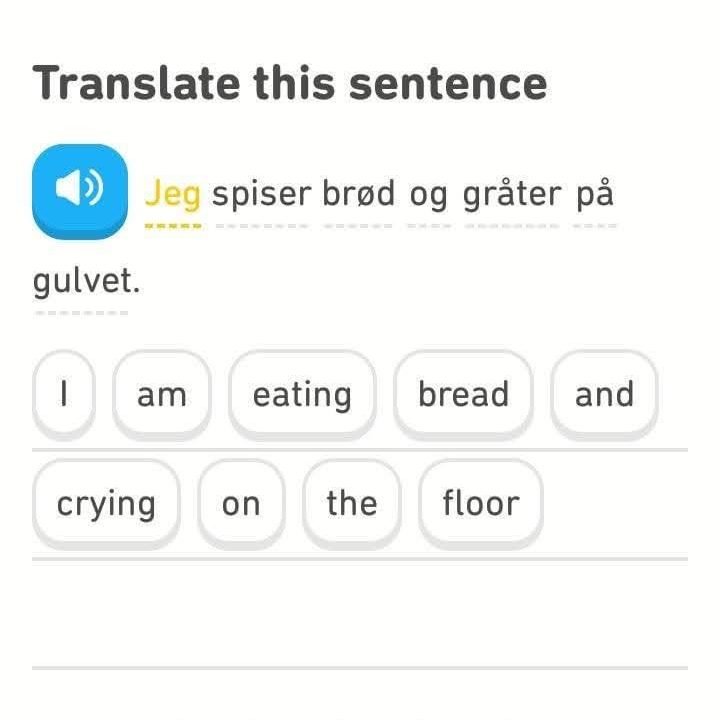I’m currently trying to learn Spanish, and since language courses are unfortunately extremely expensive I decided to use an app for now. In comes Duolingo. I’m guessing that many of you have used it at one point or another, but I’ll give you a quick introduction to it anyways.
Duolingo is a language learning app founded in the US and was released in 2012. Once downloaded, you can currently choose between 43 different languages, of which 39 are available for English speakers, and all this of free of charge (although there is of course a premium version, in case you feel the need to access more functions and want to get rid of the ads). They constantly work on expanding and improving the courses they offer, and have about 49.5 million monthly active users.
Now I have to say, the idea is great, and apparently the courses are all based on proper research. But somehow, Duolingo never fully convinces me. I’ve used Babbel before, which worked much better for me, but unfortunately at this point that is almost as cost-intensive as an in-person course. One of the reasons I never quite get along with this threatening green owl is the seemingly random absurdity and uselessness of the sentences it tries to teach me. If you want to have a laugh, I advise you to watch the following video, which is basically a collection of the most hilarious sentences this app has to offer:
For a long time, I was convinced that these ridiculous sentences are just created by AI, there is actually a strategy behind it.
In fact, Duolingo works with a combination of human experts and Artificial Intelligence in a process that is divided in four stages: curriculum design, raw content creation, exercise creation, and lesson personalization. While the first stages are still mostly designed by humans, the further along they go in the process, the more the AI takes over the work.

The first stage is carefully planned out by professional curriculum designers who decide what will be taught and at what point, following the CEFR standard while taking into consideration the individual language background of the user. The reason why some of the sentences truly are random is the mere fact that a specific set of words is meant to be taught at a particular time, but some grammatical concepts that would generally make sense of them is only gonna be included later in the course. So, while they so look at vocabulary, grammatical structures and individual concepts, they do not match them well together at this point.
“All this to say, a curriculum designer is looking at the individual concepts, vocabulary, and structures that make up a sentence, but they’re not stringing them together… yet.”
Bozena Pajak and Klinton Bicknell, Duolingo
In the second stage the ‘raw’ content for each lesson is created by human experts, out of which specific exercises will be stitched together at a later point. In order to guarantee that this step will be carried out more efficiently, they are assisted by AI. This content can range from paragraphs, to sentences or dialogues that exemplify new concepts and vocabulary. The AI helps to create a variety of possible translations of the sentences for cases in which several answers could be correct. At this point the example sentences will be written, some of which are standard ones (‘I like sports.’), while others would certainly raise an eyebrow (‘My horse likes TV.’) This step is apparently mostly about having a wide variety of sentences and phrases, and not so much about the actual meanings thereof.
Now that the ‘raw’ content is created, as pool of interactive exercises needs to be created from it, which is mainly done using algorithms that automatically combine the content to exercises. These could ask you to, for example, complete a sentence, fill in a missing word or translate a sentence out of the provided words.

Finally, the lessons need to be personalized to the user’s specific abilities and needs. For this, several AI models work alongside each other, mostly using the so-called Birdbrain model, which figures out which course content needs to be revised, among other things.
But why are some of these sentences so absurd?
Sentences like “I am eating bread and crying on the floor.” do generally make sense, and currently express my mood pretty well. However, these are not the kind of sentences you would actually need to learn or encounter in any other language courses (that I know of).

The reason for that is quite simple: Duolingo wants to engage its users, and apparently these quirky sentences are more memorable than our normal day-to-day language, functioning as anchors for the newly learned grammatical structures, and enabling you to use them more flexible. And in the end, it’s all about the fun.
Quirky sentences also have a hidden superpower: they are memorable! They work as a grammatical “anchor,” helping you remember key examples of essential grammar concepts.
Duolingo
References
“the complete list of every duolingo language,” duoplanet, 17 June 2021.



This is was really funny post. I definitely have experience this in my enough to learn dutch on the this app. For some reason they are constantly talking about ducks, like if you’ve seen my duck or where is my duck. But this was interesting to know that there is some rationale behind it, with the anchoring sentences that actually stick in your head about the languages grammatical structures. Thanks for sharing.
It was a very interesting post! I also used this application to learn Spanish. Actually, I didn’t know that such a funny sentence would come out because I quit this app after not much time! But I think the language will be memorable for a long time by learning sentences that will not be used in real life. Just like memorizing interesting rules when memorizing something.
I have also been using Duolingo to attempt learning Dutch (failed attempt for nu). My brother has been loving it though and almost knows more Dutch sentences and vocabulary than me (having been to the NL twice for a couple of days only). He is not a big reader and usually struggles to concentrate and piece together grammatical rules with speaking or writing practice. However, aside from the ‘competitive’ play involved in the app (which does wonders for learning!) these random sentences really seem to stick with him! Not by chance, memory techniques will often make use of bizarre associations to help remember words or concepts. One aspect of Duolingo that definitely deserves more attention is its use of the streak to keep users engaged. At a family gathering everyone was talking about their Duolingo streak at some point , making it into a competition basically.
I have been trying to learn Dutch through Duolingo as well. It is not going well. But I have to say I had a lot more success with an app called FluentForever, in which I was studying French. The technology Gabriel Wyner uses there gave me a better grammatical and sound understanding instead of only repetitions, and I remembered more in just a few weeks. It is based on personalised flip cards and engages parts of long sentences for grammar and vocabulary practice. The guy is an opera singer he also takes care of the pronunciation with small introductions. Somehow the rhythm of the app works better in my opinion. He wrote an excellent book on how the memorisation process works, which started the whole project – Fluent Forever. Downside – it is paid 10 euros per month. But I think it’s worthed. The constant repetitions of the same with Duoling are killing me. I made it to a 70-day strike and had some ducks on my mind.
This post answered some of my questions about Duolingo; fascinating post! I hate taking courses in person, so I have always sought alternative methods to learn languages. Duolingo used to be a potential option, but then I found it’s more of a loosely structured course, and the weird sentences make it hard to know how the vocabulary is used. But still, as a free option, it’s pretty decent already.
Another point I’d like to discuss is that language-learning apps don’t work for me, which is weird because I’m usually very fond of gamification ways of learning or increasing productivity. And then I figured maybe it’s because the length of the course on language learning apps like Duolingo or Babbel is a little bit too short to learn. However, I am also aware that they are centering on using fragmented learning time. After realizing these features didn’t suit me, I turned back to the “old” way of learning… It’s perfect for me, tho, just buying vocabulary, grammar, and short story book in the language I want to learn and learn it page by page lol
great post! it’s a very interesting and funny aspect of Duolingo that I think anyone that has used the app at least once noticed. The part about Duolingo using absurdity to promote learning reminded me of something I noticed while using the app: if you screenshot a sentence, a notification appears asking you if you want to share the content of the exercise with your friends and offers you ways to do it. I find this very interesting for two reasons: first, they know their sentences are so weird you’ll probably want to share them and second, they know that by facilitating sharing they also get publicity out of it. I wonder if that’s an additional reason behind the absurdity of sentences.
That’s a good point! It’s like companies making memes to gain publicity, but in this case with absurd sentences. It definitely made me curious to start using it. I think it’s a smart move on duolingo’s part also for the effectivity of learning.
I am an active user of Duolingo myself. Though, the absurd phrases might occasionally funny, I don’t really think it helps with memorizing vocabulary. I personally think that instead of having quirky phrases, coming up with ways to digitize more conventional language teaching methods would be much more effective. Being able to say “the duck is wearing clogs” in Dutch won’t be of any help when you live in the Netherlands!
And also thanks for adding that video of compilation of funny Duolingo phrases, it’s really hilarious.
Nice post! I already knew a little bit about how Duolingo functions, but this post definitely offered me more details. I emphatically agree that sentences become more memorable the more ridiculous they are. One day, a classmate came up to me and triumphantly said in Italian, “I sliced a drink with a knife,” which made no sense at all. However, he later revealed that he had learned that on Duolingo. The person learning the language will most definitely not easily forget this strange statement, and neither will the one who hears it.